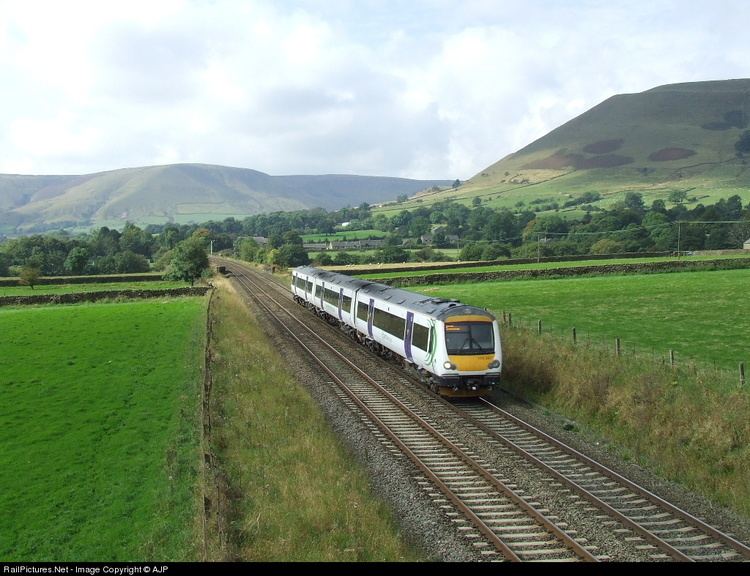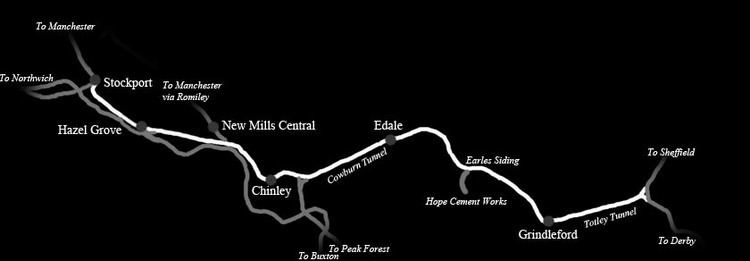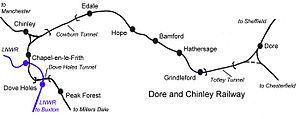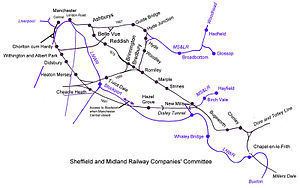Type Heavy rail Status Operational Owner Network Rail | System National Rail Opened 1894 | |
 | ||
Locale North West England
Yorkshire and the Humber Termini Manchester Piccadilly
Sheffield | ||
Northern rail class 142 pacers 150s at romiley hope valley line
The Hope Valley line is a trans-Pennine railway line in England, linking Sheffield with Manchester. It was completed in 1894.
Contents
- Northern rail class 142 pacers 150s at romiley hope valley line
- Trains at edale hope valley line
- Sheffield and Midland Joint Section
- Dore and Chinley
- Recent history
- Metrolink proposals
- Plans
- Freight
- References

From Sheffield, trains head down the Midland Main Line through the south west of the city to Dore and Totley, where the Hope Valley line branches off to run through the Totley Tunnel, the fourth-longest tunnel in England.

It emerges in the Hope Valley area of Derbyshire, where it passes through the railway stations of Grindleford, Hathersage, Bamford, Hope, and Edale before entering the two-mile-long Cowburn Tunnel.

From the western portal of the tunnel, the line runs through Chinley, then splits. The northern branch runs via New Mills toward Manchester Piccadilly. The southern branch passes through the Disley Tunnel before merging with the Buxton line and then heading to Stockport to join the main line to Manchester.
Passenger services on the line are currently operated by Northern (previously Northern Rail and First North Western), East Midlands Trains (previously Central Trains) and TransPennine Express (previously First TransPennine Express and Arriva Trains Northern).
Trains at edale hope valley line
Sheffield and Midland Joint Section
This section was built by the Sheffield and Midland Railway Companies' Committee as part of the Midland Railway's drive to reach Manchester with its line from London via Ambergate and Millers Dale. Initially, in 1867, it joined the Manchester, Sheffield and Lincolnshire Railway at Hyde Junction, running into Manchester London Road, but in 1875 a more direct route was built through Bredbury. When Manchester Central was opened by the Cheshire Lines Committee, a new line was built through Heaton Mersey. This third route was closed along with Manchester Central, apart from the section through Disley Tunnel to Hazel Grove, where it now joins the old LNWR line into Stockport.
Dore and Chinley
In 1872, the Midland Railway's only route from Sheffield to Manchester was via Ambergate. It had originally proposed a line to run from Dore to Hassop meeting its extension from Rowsley to Buxton. However, the "Dore and Chinley Railway" was floated independently in 1872, and unsuccessfully, until the Midland took an interest, since it would provide a more direct route, connecting through Chinley into Manchester. The line was authorised in 1884 and work began in 1888.
The 21-mile (34 km) line took six years to build. The terrain through Hope Valley and Edale was easy enough by Midland standards, but at each end there were formidable obstacles, negotiated by means of the Totley and Cowburn Tunnels.
Recent history
At the time of the Beeching review, the line was running in competition with the recently modernised, more direct and faster route through the Woodhead Tunnel, and its closure was suggested. On appeal, British Rail, being required to keep the Hope Valley line open to passenger traffic, instead shut the Woodhead route to passengers (and then subsequently to freight).
Metrolink proposals
In the early 1980s, proposals were put forward to convert the Piccadilly–Belle Vue–Rose Hill/Marple section of the Hope Valley line to light rail operation for the proposed Manchester Metrolink system. While construction of Metrolink went ahead, the Hope Valley line was not included in the system completed in 1992. When in 2000, proposals for a large-scale extension of Metrolink were announced by the government, these still did not include conversion of the Hope Valley line; but subsequently, planning documents from Network Rail and from the Greater Manchester Passenger Transport Authority have suggested that this route might be appropriate for tram-train operation, and as such it was suggested to the Department for Transport as a possible location for a national tram-train pilot.
Plans
Nottinghamshire County Council and the Department for Transport are investigating the possibility of adding another service that does not call at Sheffield in order to improve the journey time between Nottingham and Manchester. It currently takes 115 minutes, but the council believes it could be cut to 90 minutes. Improvements to allow faster speeds on a 2.5-mile stretch near Stockport could also shave off 2–3 minutes.
Network Rail, in partnership with South Yorkshire ITA, will redouble the track between Dore Station Junction and Dore West Junction, at an estimated cost of £15 million. This costing is based on four additional vehicles in traffic to deliver the option, however, this will depend on vehicle allocation through the DfT rolling stock plan. This work will be programmed for between 2009 and 2016, subject to funding, is conjunction with signalling renewals in the Dore/Totley Tunnel area.
Other proposals include freight loops in the Hope and Grindleford areas, again, subject to funding, in order to fit in either a peak-busting, or all-day (07:00–19:00) hourly Manchester–Sheffield via New Mills Central service, by extending an existing Manchester–New Mills Central service. It is hoped to start work in 2017 and have extra services running in 2018.
Freight
Over a million tons of cement joins the line at Earle's Sidings at Hope.
